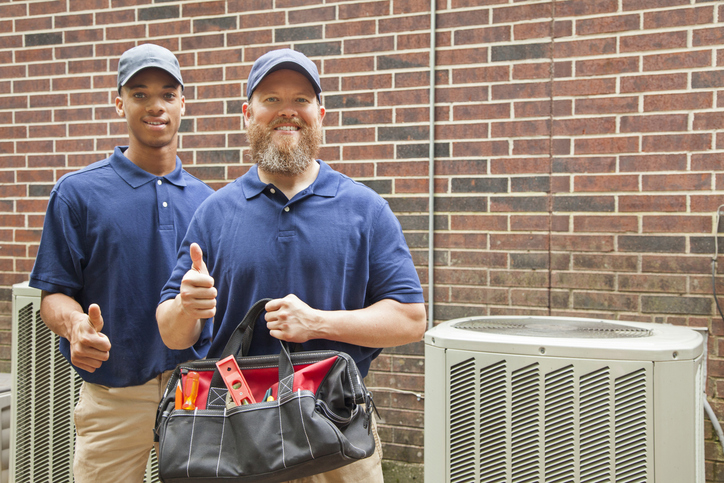
This article looks at the debt typically incurred by students pursuing HVAC certifications or degrees from a trade or vocational school.
TL;DR Summary:
HVAC training offers one of the most affordable paths to a skilled career, with trade school graduates averaging just $10,000 in student loan debt—far less than the $28,000+ average for four-year college grads. Certificate programs range from $1,200 to $15,000, while associate degrees typically cost $15,000 to $35,000, with additional expenses for tools, books, and certification exams. Apprenticeships, which may cost $0 to a few thousand dollars, offer a debt-free alternative. With median HVAC salaries around $59,000/year and opportunities for higher earnings, many technicians can repay training costs in under two years, making HVAC a strong ROI career option.
There are multiple training paths to becoming an HVAC technician, each with different costs and debt implications. The two primary routes are:
- attending an HVAC trade school or
- completing an HVAC apprenticeship
The benefits of apprenticeship are well documented. The “earn while you learn” model makes being an apprentice a cost effective way to learn a trade. Typically, an HVAC apprenticeship might cost anywhere from $0 to a couple thousand dollars at most.
But apprenticeship is not for everyone because there many situations that require attending a trade school.
With median HVAC salaries in the range of $50,000–$60,000 annually bls.gov, this relatively low debt can often be paid off quickly. By understanding the costs, financing options, and smart strategies outlined below, you can embark on an HVAC career with confidence and minimal financial burden.
Pros & Cons of HVAC Trade Schools
Trade school programs usually take 6–24 months to complete, depending on whether you pursue a short certificate or a two-year degree. Students learn the theory and practice of HVAC in a structured setting, often with experienced instructors and up-to-date equipment.
The downside is that you pay tuition, and if you rely on loans, you’ll have debt upon graduation. On the upside, trade school provides a fast, direct route into the field with formal credentials.
HVAC Training Costs
Understanding the cost of HVAC training is critical for financial planning. The expenses can vary widely based on the type of program and location.
Certificate or Diploma Programs
HVAC certificate programs (often at vocational schools or technical institutes) can cost roughly $1,200 to $15,000 in total tuition. These programs are typically 6 months to 1 year long and focus on core HVAC skills.
Shorter programs on the lower end of the cost range might cover just fundamentals or a specific HVAC area, while longer diploma programs at the higher end might include additional courses or advanced topics.
Because they are relatively short, these programs allow students to start earning faster, which can reduce the need for large loans. However, students may still finance part of the tuition if they don’t have savings or support.
Associate Degree Programs
Some community colleges and technical colleges offer a two-year Associate of Applied Science (A.A.S.) degree in HVAC technology. These 2-year programs provide a more in-depth education and often include general education courses or business classes along with HVAC training.
The cost for an HVAC associate degree typically ranges from about $15,000 to $35,000 for the full program.
Community colleges tend to be at the lower end of this range, especially for local residents. On average, in-state tuition for an HVAC program at a public community college is around $5K, while out-of-state students pay about $9K for the same program.
Private college programs or for-profit technical schools often charge more – sometimes well above $15k for an associate degree.
Why Get an Associates Degree?
The main advantage of an associate degree is a comprehensive education and possibly greater career flexibility (some employers value the degree, and it might help if you move into management later). The disadvantages are the higher cost and the longer time before you start full-time work.
Explore HVAC Associates Degrees
Additional Expenses
Remember that tuition isn’t the only expense in HVAC training. Students should budget for other mandatory costs.
Tools and Equipment
HVAC technicians require basic tools (e.g. multimeter, hand tools, gauges). Some schools provide a starter tool set or include it in tuition, but if not, you may need to buy tools. This can add about $1,000 to $2,000 in expenses for a quality tool kit.
Textbooks and Supplies
Books, safety gear, and training materials can cost a few hundred dollars. Estimates range around $500 to $1,000 for textbooks and materials over a course of a program fieldcomplete.com. Short certificate programs will be on the lower end, while a two-year degree could require more books.
Exam and Certification Fees
HVAC students typically take certification exams like the EPA Section 608 certification (for refrigerant handling) as part of their training. Programs might include these exam fees, but if not, expect to pay a fee (often around $20-$100 for EPA certification, depending on type).
Other industry certifications (like NATE) or state licensing exams have their own fees (ranging from about $50 up to a couple of hundred dollars in some cases).
We’ll cover licensing in detail later, but it’s good to be aware that these costs, while not huge individually, do add to the overall training budget.
Living Expenses During Training
Not a direct school cost, but remember that if you attend a full-time program (trade school or community college), you might have reduced income during that period. Consider the “opportunity cost” – you might be working part-time or not at all, which can affect your budget.
Still Cheaper Than a Traditional Degree
HVAC education is generally much shorter and cheaper than a traditional university degree. Many HVAC programs last only 6 months to 2 years bls.gov, so students enter the workforce faster and often with far less debt. In fact, trade school programs (including HVAC) have average student loan balances of around $10,000 – a fraction of what many four-year college graduates owe.
Typical Student Debt Levels for HVAC Training
One of the biggest advantages of pursuing an HVAC career is the potential to graduate with little to no student debt.

Studies and industry data suggest that the average student loan debt for HVAC trade school graduates is around $10,000.
This figure is an approximate national average and can vary by program type. For example, someone who completes a short certificate might have zero debt or just a few thousand dollars of debt (if they even needed loans), whereas someone who attended an out-of-state two-year program or a costly private school could owe more than $10k.
But overall, $10k is modest compared to the $28,000+ debt that the average four-year college graduate carries in the U.S. (and many university grads owe much more).
In a trade comparison, HVAC technicians have similar or slightly lower debt than other trades – for instance, electricians might graduate with ~$15k debt, plumbers ~$12k, etc..
In summary, typical student debt for HVAC graduates is modest – roughly in the low five-figures (or even zero for many apprentices).
Strategies to Minimize or Avoid Debt
Even though HVAC training is relatively affordable, it’s always wise to minimize debt wherever possible. Every dollar you don’t have to borrow is a dollar you won’t pay interest on later.
Check out this article for strategies to help you minimize student debt.
Here are practical strategies for aspiring HVAC technicians to avoid or reduce student debt:
- Work Part-Time in the Field During School: If you opt for a trade school program, try to work at least part-time for an HVAC employer while you study.
- Live at Home or Reduce Living Costs: If possible, stay with family while you attend HVAC school. Room and board is a major cost for college students that often gets covered by loans.
- Maximize Scholarships and Grants: Earlier we discussed the various scholarships and grants available. One strategy is to stack multiple small scholarships. Maybe you win a $1000 award from a local Rotary Club, plus a $500 tool scholarship from an industry group, plus you get a Pell Grant of a couple thousand – together these can cover a big chunk of costs.
- Consider Employer Training Programs: Some large HVAC companies or mechanical contractors offer their own training programs or partner with schools.
- Avoid Unnecessary Extras: Some schools might upsell students on things that increase costs, like extra certifications or fancy tool packages, which you might not immediately need. While tools and certs are important, you might not need to buy the top-of-the-line toolkit from the school bookstore at a markup.
Financial Aid and Sponsorship Options
Just because HVAC training tends to cost less doesn’t mean you should pay entirely out-of-pocket. There are many financial aid opportunities specifically for trade school students and apprentices.
HVAC Scholarships
Numerous scholarships are available for students in skilled trades and HVAC programs. Industry organizations, schools, and foundations offer scholarship funds that don’t need to be repaid.
For example, the Plumbing-Heating-Cooling Contractors (PHCC) Educational Foundation offers HVAC scholarships with awards up to $10,000 fieldcomplete.com.
There are also local and national scholarships targeting HVAC/R technology students, often sponsored by HVAC companies or trade associations. Additionally, groups aiming to diversify the trades provide aid – e.g., the “Live Your Dream” scholarship by Soroptimist offers $1,000 to $10,000 for women who are primary family providers enrolled in vocational training.
Grants
Government grants can be a major help. The Federal Pell Grant is available to students in many accredited certificate or associate programs, provided the school qualifies for federal aid. Pell Grants are need-based (awarded to lower-income students) and can provide a few thousand dollars per year that you don’t have to repay.
State grants or workforce development grants may also support HVAC training, especially in states with skilled labor shortages. For instance, some states have tuition assistance for high-demand fields or offer grants for attending community college.
Federal Student Loans
If you do need to borrow, federal student loans are usually the first choice. By completing the FAFSA, you access federal Direct Loans which have relatively low fixed interest rates and flexible repayment options.
Even trade school students can take out federal loans if their school/program is Title IV eligible (most community colleges and many technical institutes are).
Undergraduates can borrow a few thousand dollars per year through subsidized and unsubsidized loans.
Employer or Union Sponsorship
A fantastic option in the HVAC field is to have an employer or union sponsor your training costs. Some HVAC companies will pay for your trade school or certification if you commit to work for them for a certain period after completion.
Military and Veterans’ Benefits
If you have served in the military, you can take advantage of programs like the GI Bill or the Post-9/11 GI Bill to pay for HVAC training. The GI Bill can cover tuition and even provide a housing allowance while you attend an approved HVAC program or apprenticeship.

Licensing and Certification Costs
Entering the HVAC field isn’t just about school – you also need to obtain certain licenses and certifications to legally work and to boost your employability.
However, licensing and certification costs in HVAC are relatively minor compared to tuition – usually in the hundreds, not thousands, of dollars range.
EPA Section 608 Certification
This is a mandatory federal certification for anyone who will handle refrigerants (used in air conditioners, refrigeration systems, etc.).
The good news is many training programs include the EPA certification exam in their curriculum. If not, you’ll need to take a test from an authorized provider. The cost is relatively low – often around $20 to $50 for a Type I exam (small appliances) and can be up to around $150 for Universal certification if taken through certain organizations .
State HVAC License
Many U.S. states (and some cities/counties) require HVAC technicians or contractors to hold a state-issued license to perform work independently.
Costs for state licenses vary: you might pay an application fee and an exam fee. These could range from as low as $50 to a few hundred dollars, depending on the state and the license class.
For example, a state might charge $100 to sit for the exam and, upon passing, $75 for the license itself, which you renew every year or two for a smaller fee.
Some states require continuing education courses for renewal, which have costs too.
Industry Certifications
Beyond legal requirements, many HVAC techs pursue voluntary certifications to demonstrate their skills. The most well-known is NATE (North American Technician Excellence) certification.
Another is HVAC Excellence, which offers employment-ready certification exams. These certifications can improve your job prospects or pay, as employers often value certified techs.
The cost for NATE certification typically involves paying for a core exam and a specialty exam. It can cost on the order of $150–$200 for the full set of exams (exact fees vary by testing organization and whether you need study materials). If your employer encourages NATE, they might pay for the test.
Other certifications like OSHA safety training (10-hour or 30-hour card) might cost a small fee if not employer-provided.
Earnings Potential and ROI (Return on Investment)

The earnings potential for HVAC technicians is strong, and this directly affects the return on investment (ROI) for your training costs. In short, HVAC techs can make good money, often enough to pay back any education debt quickly and then enjoy a stable income.
According to the U.S. Bureau of Labor Statistics, the median annual wage for HVAC technicians was about $59,810 as of May 2024 bls.gov. Median means half of techs earn less than that and half earn more.
To put this in perspective, $59k per year is roughly $28.75 per hour. Entry-level technicians (just starting out) typically earn less than the median – often in the range of $45k–$50k per year (low $20s per hour) depending on the region fieldcomplete.com.
Experienced HVAC technicians or those with specialized skills (like in commercial HVAC or controls) can earn $80,000 or more annually.
The top 10% of HVAC earners make over $90k per year in some cases. Salaries also vary by location – areas with high demand or higher cost of living (for example, big cities or regions with extreme climates) tend to pay more.
Now, consider ROI: Return on investment = (Benefits of education – Cost of education) / Cost of education.
For an HVAC tech, the “benefit” can be seen as the salary earned due to the training. If you spend $10,000 on a training program and then land a job paying $50,000 a year, that’s a great ROI – your first-year earnings are 5 times your educational cost! Even subtracting living expenses, etc., that’s a quick recovery of your investment.
Many HVAC grads find they can pay off a typical training debt very fast. For example, an HVAC tech making around $65k could pay off a $10k student loan in roughly one year by dedicating a portion of their income to it.
Compare this to a new college grad: they might have $30k debt and a $45k salary – a tougher ratio to manage.
Let’s crunch a simple ROI scenario: suppose you spend $15,000 on an HVAC associate degree program. You finance it with $5k of your savings, $5k from working part-time, and $5k in student loans. Upon graduating, you get a job at $50,000/year.
If you live modestly, you could pay off that $5k loan in the first year or two. After that, your ongoing costs are just normal living expenses and any further training you choose. The $15k investment leads to a $50k annual return – by the second year you’ve “broke even” and every year of income after is profit on your education investment.
Conclusion
Becoming an HVAC technician offers a promising balance of affordable training and solid earnings. With careful planning, you can launch your HVAC career with little to no debt and quickly achieve financial stability.
This field highly values skilled workers, so there are often resources to help you succeed (after all, the industry wants new well-trained techs to fill the labor demand). The fact that HVAC employment is expected to grow about 9% in the coming decade bls.gov means you’re entering a stable market with plenty of opportunity.
Overall, HVAC training costs are significantly lower than the cost of a four-year college degree. For comparison, a four-year bachelor’s degree can easily cost $40,000 to $100,000+ in tuition, depending on the school, often leaving students tens of thousands in debt. HVAC programs, by contrast, typically cost under $15,000 for a certificate and under $35,000 even for a longer associate program.
